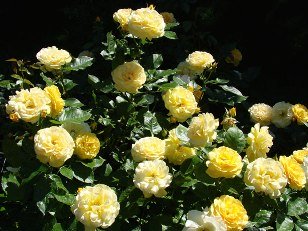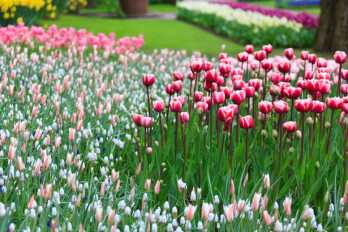Starting A Garden, Easy To Follow "How To" Articles On Starting Your Own Garden
Starting a garden, including starting a vegetable garden, is made easy with our "how to" articles that guide you easily through the whole process. Everything you need to know about starting your own garden from scratch.
Gardening Tips and Advice, A beautiful and practical garden
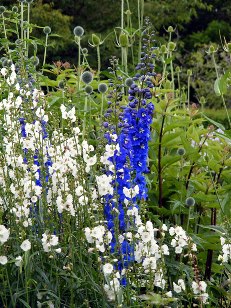
Your garden needs to fulfill two tasks, it needs to be both practical and pleasant. You need to have a garden that you want to spend time in but at the same time it needs to suit your needs.
Most people want their garden to be a retreat, an escape from the pressures of life. With this in mind many gardeners both beginner and experienced choose to opt for informal garden layouts. They prefer to start a garden that does not have the harshness or rigidity seen in normal life.
To get this effect they will choose softer curves rather than straight lines, they will choose many plants that will spread and tumble across borders or lines with the effect of breaking up those lines.
But it does need to be practical. You don't want small, fiddly strips of lawn that are going to be a pain in the neck to mow. You don't want to grow trees that are going to cast a large shadow over your entire garden.
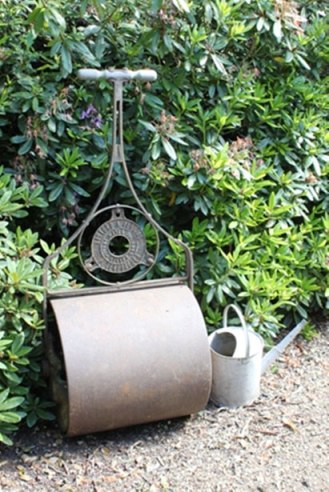
That may sound obvious but these are mistakes that are often made, don't make any rash decisions, as the expression, "act in haste, repent at leisure" springs to mind!
Gardening tips and advice for starting a garden
- First of all , find out the aspect of your garden, a tall row of trees planted on the south side will cast heavy shadow over most of the plot. Find out where north is and plant with the suns path in mind.
- Make sure that your soil is well drained and in good shape before you plant anything, spend some time on this and it will reward you many time over. At the bottom section of this page you will find tips that will easily guide you through the process of preparing your garden for planting. Our section on starting a vegetable garden also includes a lot of good information on preparing your soil. This is an area that that key to your sucess in starting a garden that meets all your needs and wishes.
- Use trees and shrubs as the spine of your planting scheme. Make good use of evergreens, and that way you are sure that there is always something to look at all year round.
- If you are planning on including garden features that need sun e.g. greenhouse, these features will have to be sited in an open, sunny position.
- Most people do not have the time or money to get everything done quickly. If you can, try to start near your home, this will give you something to look at while at the same time hiding the more unsightly parts of your garden.
- Try to include a section of your garden that is not visible from your home or road, use this as a little haven, some where you can retreat to in private.
- Don't be afraid to look around and see what others have done with their garden. Ask questions as most people will gladly answer.
- Remember, there is no such thing as a perfect garden and that you will always be trying out something new. No garden stands still, gardens evolve and change with you.
- No easy way around this. Cut everything you deem unwanted down as close to ground level as you can.
- If you are starting a large garden, you might have to resort to using weedkillers. If so, please read instructions carefully and do exactly as stated.
- You will need to turn over the soil. Preferably you should dig it up with a spade. Using a rotovator only chop roots into smaller pieces and leaves them back in the soil to grow again. If it is going to be a large garden, you might have no choice but to use a rotovator. If so, try to pick out as much of the roots as possible.
- Using a spade means that you get deeper into the soil meaning that it is also easier to work in some some soil conditioner such as compost.
- Work in some compost into the soil and then cover the entire area with a good mulch of organic matter to a depth of about 3 inches.
- The type and amount of soil conditioner you need will depend on your soil type. When starting a garden from scratch knowing your soil type is vital. Below you will find out how to judge your soil type and what you will need to do to improve it.
- Sandy soils are `light` and easy to work but are often lacking in nutrients and quick to dry out in the heat of summer.
- Clay soils become very compacted and hard as rock and become spongy/stodgy when wet. They are very difficult to work with whatever the time of year. In addition this soil type is also very slow to warm up.
- Stony soils could be either sandy or clay type.
- Peaty type soils are generally very good to work with, they retain moisture well, for certain plants peat type soil will not work as peat is too acidic.
- Regardless of your soil type it is sure to need some improvement. Indeed, conditioning your soil over the following years will be a very important part of having both a beautiful and practical garden. In that regard the work you put in now will pay off many times over in the years to come.Unless something very dramatic happens you will never have to put in as much effort as you do at this stage.
- Very well rotted manure (preferably over a year old) and compost are ideal, but leaf mould and composted bark will also work very well especially with the addition of a general fertilizer. Leaf mould and composted bark need the fertilizer because they lack nutrients contained in compost and manure, which will fuel both beneficial soil bacteria and plants.A bucketful per square meter will do the trick.
- Work this soil conditioner into the soil in the Autumn/Winter period. If you soil is heavy clay, work in plenty of sharp sand to break it up and lighten it. Remember though that you still need the fertilizer as the sand contains no nutrients.
- If your soil is very stony you can try to remove some of them, but don't spend too long at it. Your time would be better spent adding plenty of good rich manure to the soil. This way your soil is rich and the plants will be well able to deal with the stones.
Starting a garden, clearing your plot.

Judging your soil type when starting a garden.
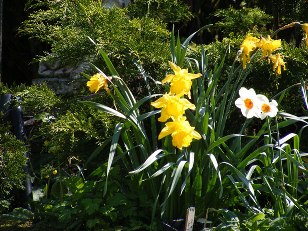
Improving your soil when starting a garden
